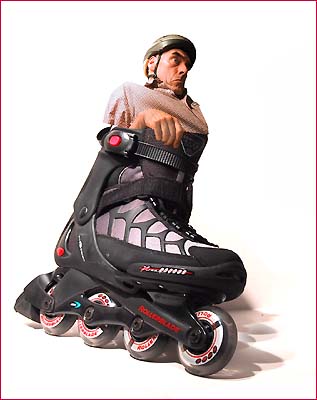| Four Wheel Drive |

| The Dutch Inline Skating Community has developed a contraption enabling anxious candidate students to take thoroughly protected test drives. An enterprising travelling fair operator has already communicated his interest in the concept while the Senior Citizen Union has inquired into the possibilities for developing a special walker version. Although the potential for such a trolley-like contraption is certainly there, far be it from me to answer for the consequences. |
|
There are quite a few activities that look so straightforward as to suggest
to me that it would be a piece of cake to take them up myself, and it's
usually due to lack of time that I never get 'round to them - an impasse I
recently broke out of to some extent because of my daughter, by enrolling in
an inline skating course. I can assure you that this has been a most unusual
experience.
Inline skating is a life-threatening activity, it turns out. Assuming that you have at some point in your life mastered the fundamental methods of locomotion in the Netherlands, these being walking, cycling and skating, you will doubtless have memories of failed actions and their painful consequences. Then again, at least you have mastered the relevant techniques. I can imagine that this is one of the reasons why inline skating doesn't sound like a big deal to you. Don't we all remember innocuously scrabbling along the pavement on heavy metal roller skates, lurching left and right to avoid our contemporaries who were busy playing hopscotch and shooting marbles? Scrabbling was the operative word, for those iron roller skates went very, very slowly. Not so inline skates. The first discovery you make is that unlike popular belief, the Netherlands is far from flat as a pancake, as witnessed by the fact that the wheels of one's skates are forever trying to escape in unpredictable directions, and although this is something one gets used to, it's a complication one never comes across while skating on ice. Also ice rinks or frozen canals tend to be devoid of kerbs, motorcars, mopeds and that most dictatorial means of city transport, the bicycle. In my childhood some of my friends could jump over a piece of wood while on skates - a feat I never mastered notwithstanding my many years of skating experience. This is another big difference when moving along on inline skates. During the third lesson of my course I was fortunate enough due to lack of time to be spared the challenge of negotiating a foot-and-a-half wide, just-about-level and intimidatingly grooved manhole cover, but on the way back from the practice square to the sports centre I could not get out of having to skate down a ski jump, by way of a grand finale of sorts. (Actually it was merely a wheelchair access ramp, but somehow it doesn't feel that way when you're inexorably heading towards it.) In situations like these I cannot help calculating the speed at which my helmet-encased head would approach the ground, based on a forward velocity of some 10 miles per hour in conjunction with an unsuspected barrier looming up ahead of my wheeled feet (even though I hardly need an excuse for losing my balance). The approximate combination of my height and this horizontal speed with the effect of the lever principle as well as gravity makes it clear even without going into decimal places that the impact of the blow will be mind-numbing. Aware as sensible people may be of their fragile status, things tend to look kind of different in circumstances like these. Quite appropriately the inaugural lesson kicks off with a spot of falling practice. As you are required to wear an outfit which would not look out of place on your average Power Ranger, the gear can hardly be the problem. Rather, it's the illogical scenario of voluntary hurling yourself to the floor that makes you hesitate. You soon realise that you simply cannot fall of your own free will. After a few gingerly executed crawling attempts, you find that you nothing can harm you, and before you know it you and your fellow students are enthusiastically clattering to the floor, like medieval knights having been unseated from their horses. If they ever feel the need to rejuvenate the Passion Plays in Limburg, this could be an interesting option. A less fortunate detail is that when losing one's balance, one usually ends up keeling over backwards rather than forwards, which proves the point of wearing a pair of leather trousers with an integrated camel saddle. Who said assimilation was beyond reach? Falling practice over, it's time to concentrate on braking. If you know how to skate, you should be extra careful: you'll be gathering speed before you know it, at which point your only hope will be finding a lamppost or other fairly tall item of street furniture to embrace. Braking turns out to be one of the most challenging aspects of inline skating, with the brake pad on the novice's right shoe being just about as effective as a spoiler on a VW van. Your instructor patiently shows you how to splay your legs to come to a complete standstill. It's just that your hip joints beg to differ, as do the wheels under your feet. Then again, you'll agree with me that this is hardly the sort of excuse that would convince my daughter. |